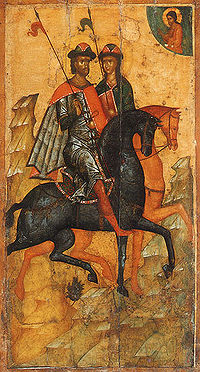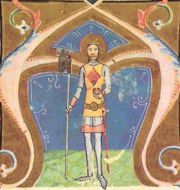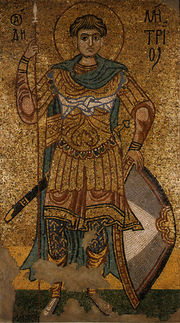- Military saint
-
- See Khalsafor the concept of "warrior-saint" in Sikhism.
 Saint Gereon, by a 15th-century German artist
Saint Gereon, by a 15th-century German artist
The military saints or warrior saints (also called soldier saints) of the Early Christian Church are prominent in the history of Christianity. The persecution of Christians under Diocletian or other Roman Emperors usually furnished the background for soldier-saint hagiography which has a common theme: a soldier of the Empire who has become a Christian finds that his devotion conflicts with traditional religious practices of the Roman military. Refusing to participate in rituals of loyalty to the Emperor (see Imperial cult), he is subjected to corporal punishment that escalates to torture—which miraculously may not affect him—but he does not deny his faith and is martyred. Such a saint was an "athlete of Christ" (athleta Christi).
Contents
Significance
In Late Antiquity other Christian writers of hagiography, like Sulpicius Severus in his account of the heroic, military life of Martin of Tours, created a literary model that reflected the new spiritual, political, and social ideals of a post-Roman society. In a recent study of Anglo-Saxon soldier saints (Damon 2003), J.E. Damon has demonstrated the persistence of Sulpicius's literary model in the transformation of the pious, peaceful saints and willing martyrs of late antique hagiography to the Christian heroes of the early Middle Ages, who appealed to the newly-converted societies led by professional warriors and who exemplified accommodation with and eventually active participation in holy wars that were considered just. A similar development in the cult of Saint Demetrius of Thessaloniki has been observed; although always described as a soldier, depictions of him were in civilian dress for centuries until around the turn of the millennium, after which he is nearly always shown fully armed.[1]
The angelic prototype of the Christian soldier-saint is the Archangel Michael, whose earliest known cultus began in the 5th century with a shrine at Monte Gargano. The cult of soldier-saints followed the transformation of Michael into a Christian figure.
The Orthodox military saints are on the whole more prominent in the respective devotions of their churches than the Catholic ones, especially as the military crisis of the Byzantine Empire deepened. They are usually shown fully equipped for fighting, unlike many Catholic military saints. The most important are Saint George, Saint Demetrius of Thessaloniki (these two very often paired, riding on horseback or on foot in icons), Saint Theodore the General, and Saint Theodore the Recruit. It is noticeable that a historical basis for all of these is essentially lacking. Boris and Gleb, historical princely figures, were added to the Orthodox list during the conversion of various Slavic countries.
Of these St George was imported to the West during the period of the Crusades; becoming perhaps the most important military saint depicted "on active service" in the Catholic world - St. Sebastian was nearly always depicted as a martyr. Like his Byzantine comrades, George is usually depicted fully armed.
Soldier-saints tended to appear in troubled times: a second wave of soldier-saints with sounder historical character appeared in the High Middle Ages, not least of whom is Joan of Arc.
A later type of soldier-saint is Saint Ignatius of Loyola, who gave up military service to form a religious order.
List of military saints
 Boris and Gleb, the first East Slavic military saints. An early 14th-century icon from Moscow, essentially copying the usual Byzantine depiction of Saint George and Saint Demetrius of Thessaloniki
Boris and Gleb, the first East Slavic military saints. An early 14th-century icon from Moscow, essentially copying the usual Byzantine depiction of Saint George and Saint Demetrius of Thessaloniki
 Saint Ladislaus I of Hungary.
Saint Ladislaus I of Hungary.
- Acacius of Byzantium, patron saint of soldiers
- Adrian of Nicomedia
- Saint Alfred the Great
- Saint Crescentinus
- Saint Demetrius of Thessaloniki
- Saint Eustace - a Roman general, but in the West usually shown hunting.
- Saint Florian
- Saint Francis of Assisi
- The Four Holy Marshals
- Saint George
- Saint Géréon of Cologne
- Saint Ignatius of Loyola
- Saint James the Great, reimagined as "Santiago" during the Spanish Reconquista
- Saint Longinus, who pierced Christ's side at the Crucifixion
- Saint Joan of Arc
- Saints John and Paul
- Saint Ladislaus I of Hungary. His cult developed with deep roots in the Medieval Central Europe.
- Saint Marcellus the Centurion
- Saint Martin of Tours
- Saint Maurice and the "Theban Legion" (Saint Candidus et al.)
- Saint Mercurius
- Saint Michael
- Saint Menas
- Saint Nuno Álvares Pereira
- Saint Orestes (Edistus)
- Saint Sebastian
- Saints Sergius and Bacchus, protectors of the Byzantine army
- Saint Terence of Pesaro
- Saint Theodore of Amasea, also known as Theodore the Recruit or Theodore of Euchaita
- Saint Theodore the General
- Saint Typasius
- Saint Victor
- Saint William
See also
- Christians in the military
- Patron saints of the military
- Saint George: Devotions, traditions and prayers
Bibliography
- John Edward Damon, 2003. Soldier Saints and Holy Warriors: Warfare and Sanctity in the Literature of Early England. (Burlington (VT): Ashgate Publishing Company) ISBN 0-7546-0473-X.
External links
- David Woods, "The Military Martyrs": 21 soldier saints, including Demetrius, George, Christopher
- "Saints John and Paul, soldier martyrs", said to have been put to death by the Emperor Julian the Apostate in 362. (See John and Paul).
References
- ^ see his article
Categories:- Types of saints
- Lists of saints
- Roman Catholic Military Ordinariates
- Military chaplains
Wikimedia Foundation. 2010.

